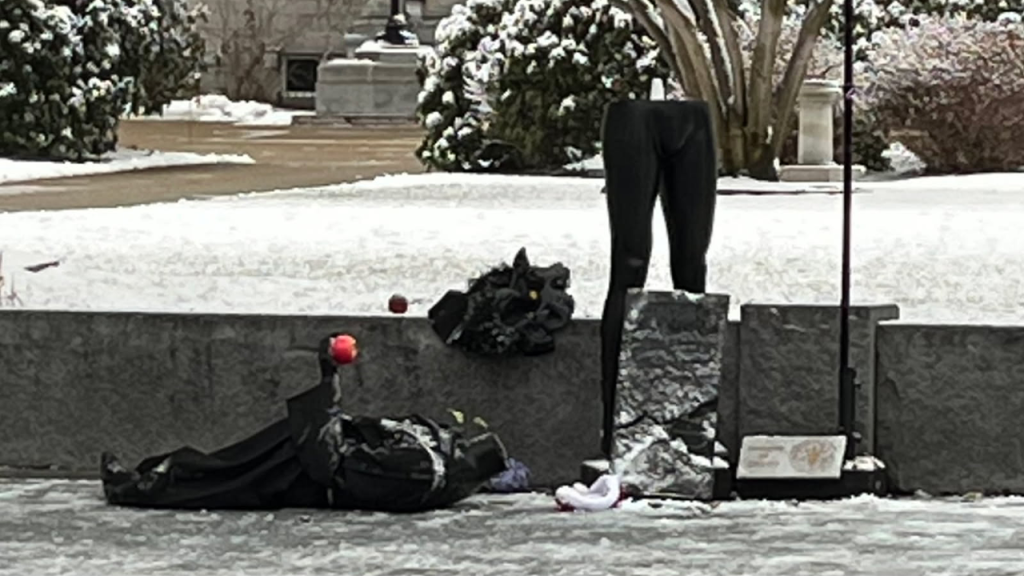The erection and subsequent destruction of a satanic “nativity” display on Concord city property near the New Hampshire State Capitol has ignited a contentious debate surrounding religious freedom, free speech, and the boundaries of public displays. The display, featuring a statue of Baphomet, a prominent figure in occultism, was erected by The Satanic Temple (TST) after securing a permit from the Concord City Council. This approval followed a series of vandalism incidents targeting the display, prompting Democratic State Representative Ellen Read, a self-proclaimed member of TST, to advocate for the group’s right to reinstall the statue. Read argues that allowing the display is a necessary response to the acts of vandalism and hatred, reinforcing the principle that such actions should not go unchecked. This incident has sparked wider discussions about the interplay between religious expression, public spaces, and the potential for controversy when diverse belief systems intersect.
The Satanic Temple, despite its provocative name and imagery, emphasizes its mission of promoting benevolence, empathy, and opposition to tyrannical authority. The organization’s website highlights its engagement in various social justice initiatives, including challenging hate groups, advocating against corporal punishment, and protecting reproductive autonomy. TST frames its public displays, such as the Baphomet statue, as assertions of religious equality and a challenge to what it perceives as the dominance of traditional religious symbols in public spaces. The organization argues that by allowing Christian nativity scenes, governments must also accommodate other religious expressions, even those considered unconventional or offensive by some. This strategy of invoking legal and constitutional principles to gain access to public spaces has been employed by TST in various locations across the United States.
The Concord City Council’s decision to grant TST a permit for the display was driven primarily by legal considerations, specifically the First Amendment’s protection of religious freedom and the potential for a lawsuit if the permit were denied. Concord Mayor Byron Champlin, while expressing his personal disapproval of the display, acknowledged the city’s legal obligation to avoid discrimination based on religious viewpoints. Champlin criticized TST’s motives, suggesting that the organization’s primary goal was to advance a political agenda rather than genuinely contribute to religious pluralism within the community. This tension between legal obligations and personal convictions underscores the complex challenges faced by municipalities when balancing constitutional rights with community values.
Representative Ellen Read, while supporting TST’s right to display the statue, has clarified that she does not actively participate in the organization’s meetings or events, characterizing her membership as primarily ideological. Read has criticized Mayor Champlin’s stance as narrow-minded, arguing that it fails to acknowledge the diversity of beliefs within the community. TST’s decision to erect the statue and the subsequent acts of vandalism have exposed deep divisions within Concord regarding religious tolerance, free speech, and the appropriate use of public spaces for religious expression. The incident has also raised questions about the role of provocative displays in fostering dialogue or exacerbating existing tensions.
The vandalism of the Baphomet statue has initiated a police investigation, adding another layer of complexity to the situation. The destruction of the display raises concerns about the protection of free speech rights, even for those expressing unpopular or controversial views. The incident underscores the challenge of maintaining civil discourse and respecting diverse perspectives in a society grappling with increasingly polarized viewpoints. The ongoing investigation will likely further fuel the debate surrounding the display, prompting discussions about the balance between freedom of expression and the prevention of vandalism and acts of intolerance.
The Concord incident is not an isolated event; TST has engaged in similar actions in other states, often placing its displays near traditional Christian exhibits during the holiday season. These actions, including the installation of a Baphomet statue at the Iowa State Capitol and a crocheted serpent display in the Illinois Capitol rotunda, demonstrate TST’s strategic approach to challenging religious norms and asserting its presence in public spaces. The repeated vandalism of these displays highlights the persistent tensions surrounding religious pluralism and the challenges of accommodating diverse belief systems within the framework of constitutional rights. The ongoing debate surrounding TST’s actions and the reactions they provoke will likely continue to shape the discourse on religious freedom, free speech, and the boundaries of public expression in the United States.

